Customer reviews: How a tiny team drove 46% more reviews in just half a year

Customer Marketing Specialist

Share
Let’s face it. Most businesses have great websites and advertising that talk about how great their products and services are. Many might even have really competitive pricing. But it’s no longer enough to have a great product range at agreeable prices.
Consumers have gotten smarter, and often, your most effective marketing isn’t even being done by your company. It’s being done by your customers—specifically, the ones who are leaving glowing customer reviews for you online.
If you’ve ever read customer reviews online before buying something, then you’ve already seen the power of reviews.
For Dialpad, customer reviews are one of our best marketing tools because, well, customers love us! It’s one of our biggest advantages over our competitors—but we had a problem. Customers weren’t leaving a ton of reviews for us on third party software review websites like G2.
The problem wasn’t that our customers felt lukewarm about us either. There were many folks who we knew loved Dialpad from our conversations with them—as a Customer Marketing team, our goal was to figure out how to reach them and make it easy for them to leave reviews for us.
In this post, I'll show you how to get these reviews and more importantly, use them to grow a business.
How customer reviews can benefit your business
There’s a reason why so many people buy things on Amazon. It’s the same reason why so many people book vacations and hotels after checking Tripadvisor.
Customer reviews are an absolutely essential factor behind the success of many brands in the ecommerce realm and beyond. Here are seven reasons why (yes, there really are seven ways to use these reviews):
They can get you more new customers
It’s a competitive world out there, and having reviews on your site can give your conversion rates a serious boost. Don’t have any reviews online? Your potential first-time customers can easily go to a competitor that does have lots of online reviews and buy from them instead.
They can help you create more accurate customer personas
Customer reviews are a treasure trove of valuable insights. What do your customers love about you? What do they hate? (Hopefully not too much.) This information can help you refine your customer personas, tailor your messaging to each one (for example, “ease of use” comes up a lot in our reviews, so we use that language!), and ultimately, sell to these groups more effectively.
They make you more money(!)
One of the biggest benefits of having customer reviews—and specifically, lots of good online customer reviews—is that it helps your business’ bottom line. Literally. For example, G2, a third party review site, have specific modules on the site that let prospects get a demo and that also have tracking so that you can see how many of your prospects are coming from their website.
They help you improve your customer service
Great service is about listening to your customers and offering solutions when they have a problem. (We respond to all negative reviews to see how we can turn things around for our customers.) And you’ll find answers to all of those things in—you guessed it—customer reviews. (Learn more about different customer service techniques.)
They give your business more credibility
Which do you think a prospect is going to believe more—your website saying that you’re the best, or 178 customer reviews on Google or Yelp (or other third party review sites) saying that you’re the best?
That’s the power of social proof and advocacy from someone else who's not from your company.
And if you’re in the software business, reviews are also the key that’ll unlock doors to awards and inclusion on reports like Gartner’s Magic Quadrant and G2’s Grid. (We also use reviews extensively across our website!)
Always remember that positive reviews are a means to an end. When it comes to G2 and Gartner, for instance, you want to be in the Leader quadrant (up and on right). When enterprise prospects are evaluating vendors, they look at those things—your placement can determine if you get a seat at the table or not.
They can increase customer retention
This one is a bit of a tricky one. Building a sound relationship with your customers is, of course, essential to retaining them. And it’s important to respond to customer reviews—especially the negative ones.
But often, a customer who posts a negative review publicly only does it as a last resort because they’ve exhausted every other channel. That means they’ve likely tried calling you, emailing you, and live-chatting with you—and you either ignored them or couldn’t give them a satisfactory resolution.
Ideally, it should never reach this point because even if you “fix things” after a bad customer review, it’s still a pretty frustrating experience—and you may not end up keeping that customer. But you have to do your best anyway because that public review will stay up there until they either take it down, or update it with hopefully a positive note on how you resolved their issue.
They’re basically free marketing
One of the best things about customer reviews and testimonials is that they’re a great source of marketing for you. For one, they’re basically free—which is especially nice if you’re a small business owner. And as I mentioned earlier, they’re perceived as being much more credible than other marketing tactics.
✨ Want to get glowing customer reviews?
Grab the Contact Centre Playbook, which breaks down everything you need to know, from setup to improving customer satisfaction—with examples from real contact centre teams across different industries.
6 methods for acquiring customer feedback
There are quite a few ways you can get this valuable customer feedback. Here are a few of my favourites.
1. Post-purchase reviews
If you get the timing right (online retailers are great at this), you can get a lot more customer feedback—and the post-purchase period is one of the best times to solicit customer reviews.
For example, you could try to target accounts or customers who recently renewed their subscription with you or made a repeat purchase. If they renewed, you know that they’re at least happy enough to stick with you. The other benefit here is that they’ve probably used the product or service long enough to provide actual insight into how they’re using it day-to-day—and might even be able to give you some numbers. (“We’ve been saving eight hours a week with your product!”)
2. Surveys
Short surveys are a great way to get feedback because they’re fast and (generally) hassle-free. Some good examples include YouTube’s “thumbs-up/thumbs-down” option, or the “How was your call?” question you’ll see after using video conferencing software. These also tend to get you more accurate responses because the interaction is fresh in your customer’s mind.
For most businesses, every phone call with a customer is an opportunity to get this feedback from them. For example, you can easily autoplay a customer satisfaction (or CSAT) survey after a call, and get your customer or caller to rate that interaction by punching in a number on their phone.
In Dialpad, you can easily set this up in a few clicks:
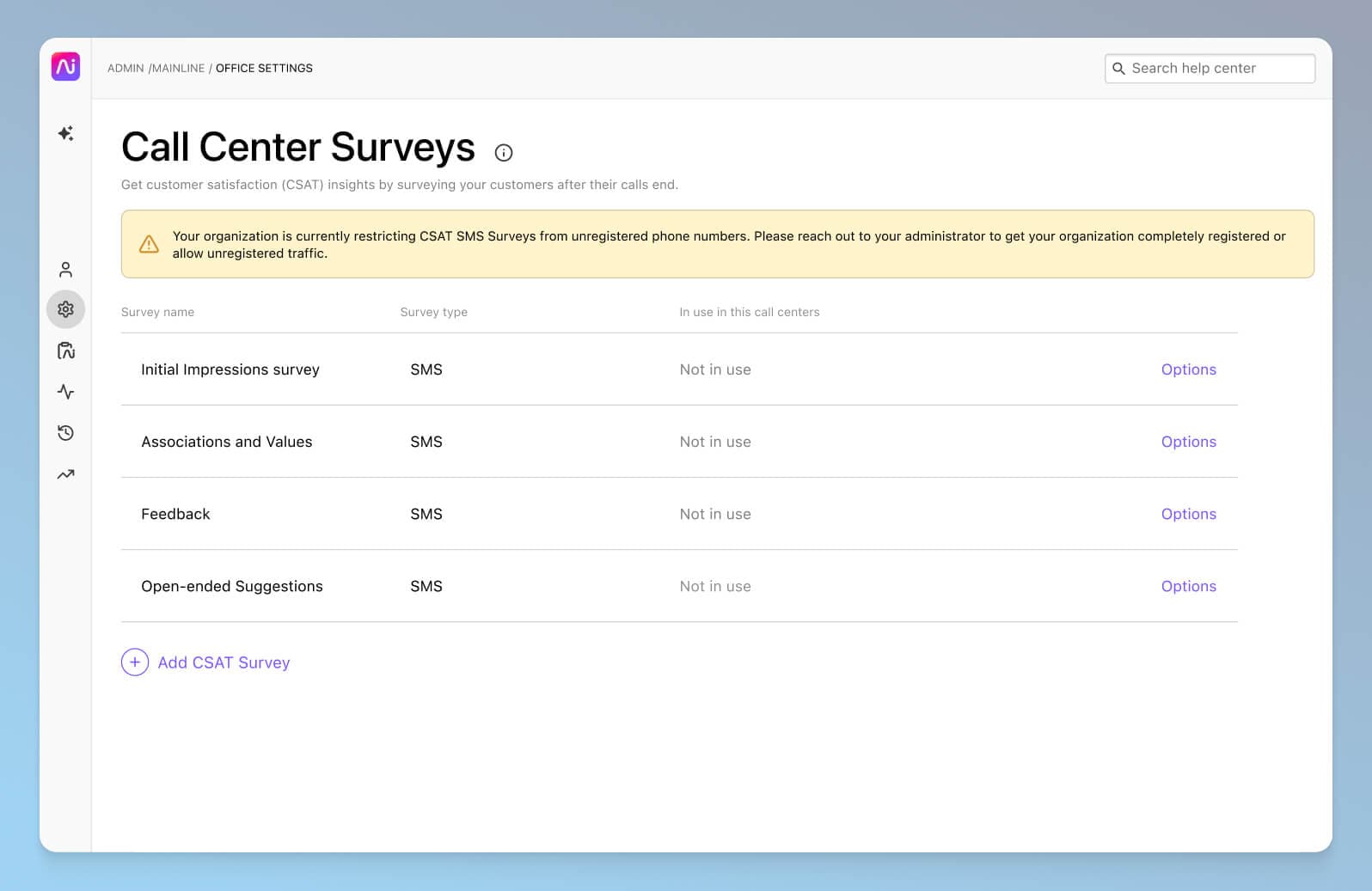
You can even set it up to ask them to elaborate on why they gave you a certain score—it’s a great way to start logging positive customer reviews.
The thing is, one of the biggest challenges by far with CSAT scores is that not a lot of people actually fill out those surveys.
In fact (depending on the industry and specific business of course), we've found that on average only about 5% of customers actually fill out CSAT surveys. On a related note, usually only the angriest—and happiest—customers actually bother to respond to these surveys, which means your CSAT answers are likely to be very skewed and not representative of how your customers feel overall.
Dialpad's industry-first Ai CSAT feature is designed to solve exactly that. Not only can our Ai transcribe calls and analyse sentiment in real time, it can also infer CSAT scores for 100% of your customer calls thanks to its hyper-accurate transcription feature. The result? A much more representative sample size for CSAT scores, and a more accurate understanding of how satisfied your customers really are:
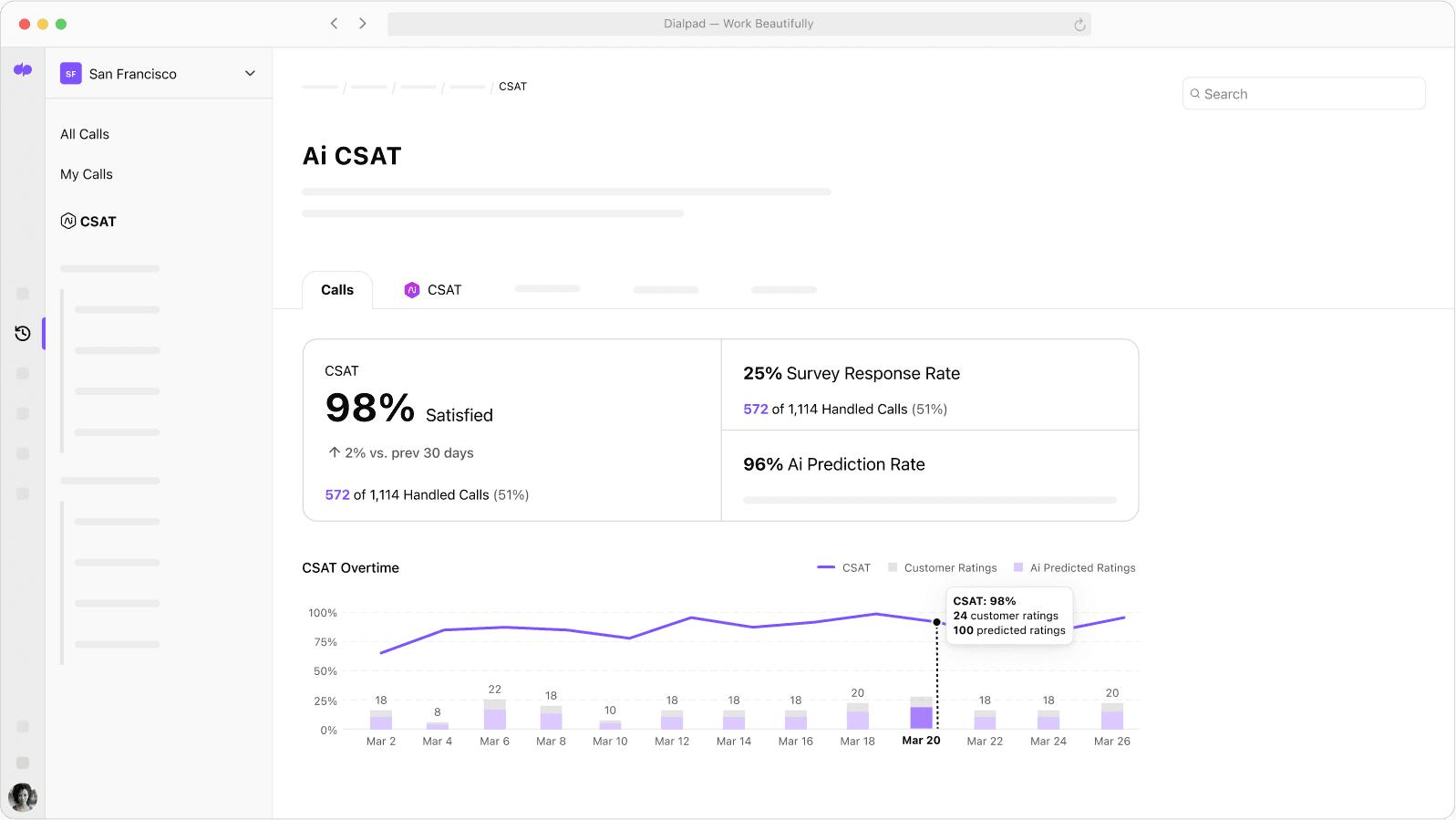
It's a whole new way of gathering customer intelligence, on a larger scale than was ever before possible.
3. Email
Email is still one of the most frequently used methods to request customer feedback. We’re all used to receiving confirmation of our online orders through email, and post-purchase feedback requests are a pretty common and widely acceptable way of getting feedback.
4. Reviewing recorded calls and transcripts
Recorded calls and transcripts can offer vital feedback for a brand. For example, a customer may have commented on how great your service is while they’re chatting with an agent—even though they were calling about something else entirely.
We love using Dialpad because our calls are transcribed (in real time)—which means we can easily go in and find customers who love our product… And ask if they want to write a review for us:
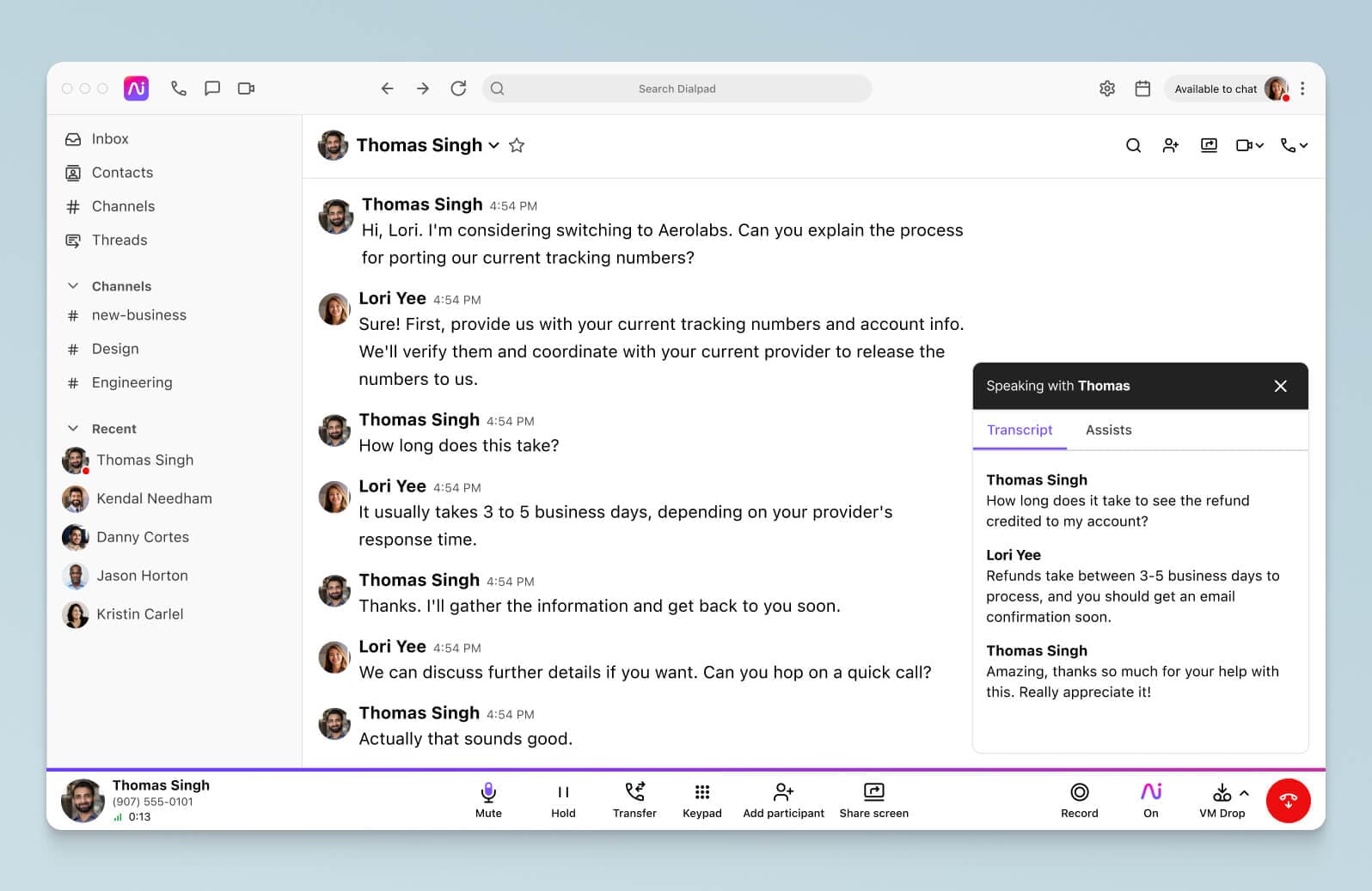
But Dialpad Ai doesn’t just do real-time transcriptions—it can also pick out keyphrases that we choose.
For example, if I wanted to find customers who view us positively, I can create a “Custom Moment” in Dialpad to track every time someone says “love Dialpad” or “useful” (or any other similar words or phrases that might indicate their affinity for us):
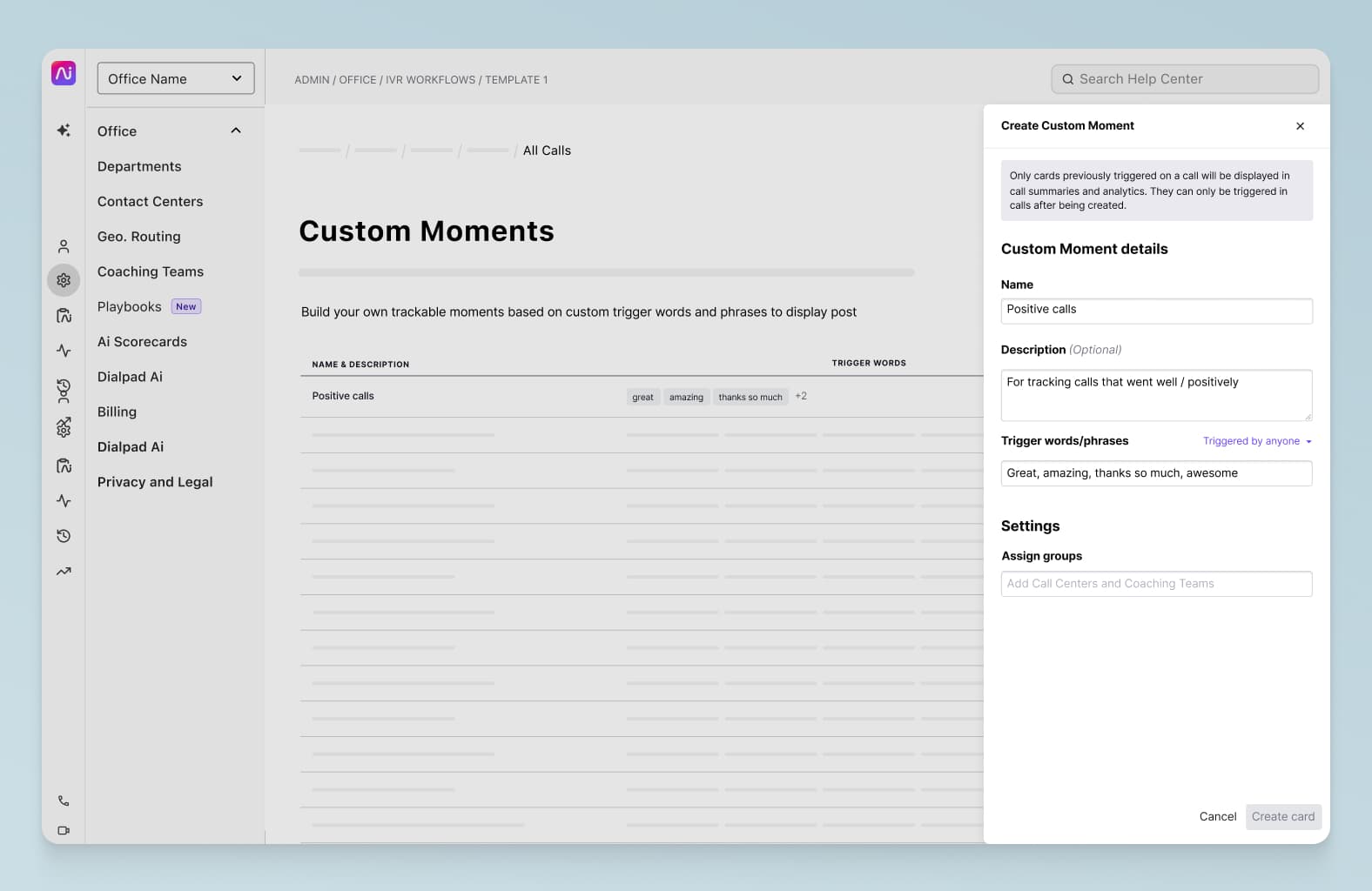
From there, I can dig deeper into those transcripts, and reach out to those customers if I think they’d be open to writing reviews for us.
5. Text messaging
If you’ve ever responded “YES” to an appointment confirmation over text or gotten updates on your online order through text, then you’re probably already comfortable with interacting with businesses via SMS.
And even though most organisations and businesses use SMS to confirm appointments and orders—who’s to say you can’t use text messaging for short surveys to get feedback?
6. In-app messaging
This one is more for if you sell a piece of software or something that has a mobile app, but having in-app messaging (not too many!) that pops up to ask your users to leave a review at strategic touchpoints is another great way to get feedback.
Best practices when you're getting customer reviews
Make it easy for customers to leave a review
People are using up their own precious time to write a personal recommendation for you, so don’t make them work for the privilege. Offer a range of review options, from your website’s contact form to social media, email prompts, SMS, or even directly through the app if you’re a software provider.
Keep the negative reviews
Keeping negative reviews can be a huge plus-point—as long as you respond in the right way. Firstly, they give your business credibility. Customers know that it’s impossible to please everyone, and they’d probably get suspicious anyway if all they find is a list of positive reviews next to a product.
Too many compliments and the “fake reviews” alarm can start ringing in people’s minds.
You can also use bad reviews as a means of showing how responsive your customer service is. It’s not always necessary to respond to every negative comment (especially if it's obviously not a reasonable complaint)—but if the gripe is something that you can fix, add a note to the review, and take the issue offline.
Then, you can contact the customer one-on-one to try to resolve the problem. This way, people reading the review can see how proactive your business is and feel more secure about buying from you.
Provide the option for different media
As I mentioned earlier, it should be easy for customers to leave reviews in different places online. If you have a large number of reviews on your website, but nothing on Google or Yelp or other third party sites, then things might look a bit suspicious to your potential customers.
Of course, if your customers only write Facebook reviews and never both to do a little research on search engines, then that’s fine. But generally, it’s good to offer choices. Consider email, social media, and even Google reviews (although you’ll need a Google My Business account to do this).
👉 Dialpad tip:
You don’t have to stop at requesting a written review. Social media works best with visuals, so why not ask customers to tag and post images of themselves using your product? You could even run a social media contest as an incentive. This give your product free exposure, and customers love to see products in action before they buy anyway.
Use feedback to detect areas of improvement for product and service
Don't just collect reviews and show them off as shiny trophies.
They're a great source of ideas for how you can improve your product—use them!
And after you've made these improvements, don't forget to reach back out to the customer(s) who made those suggestions to let them know you actually did something with their feedback. Customers love to be listened to, and they’ll love it even more if they can see that their feedback resulted in real changes being made.
How to respond to reviews—both the good and the bad
Product reviews should never be a one-way conversation. Whether positive or negative, they’re a reflection of your customers' (very public) thoughts about your business and usually deserve a response. You don't have to write a long letter thanking every single person who's ever reviewed your business, but some form of acknowledgment is generally good.
Here are three things to keep in mind.
Use the feedback to improve your customer experience
I’ll get into responding to customer reviews in just a bit, but hands down one of the best things you can do with reviews is to use it!
For example, if customers love (or dislike) a certain product or service, you could share that feedback with your Product or Engineering team so that they can understand someone’s experience with what they’re creating, firsthand.
Customer reviews are also great for training and development. For example, if your reviews are all talking about how one of your products is difficult to use, you can use that to train your customer support team on that specific product.
With Dialpad, we have RTA (Real-time Assist) cards that do exactly this. I mentioned that we can create Custom Moments to track keywords—but RTA cards take this to another level.
Beyond just tracking those keywords, Dialpad can also pop up these cards (basically cheat sheets) automatically to help agents deal with difficult queries.
For example, say we notice we’re getting lots of reviews from customers who didn’t know we had a porting service. Our team can create an RTA card with notes about how Dialpad’s porting service works and set it to trigger on an agent’s screen every time “port” or “porting” is spoken on a conversation:
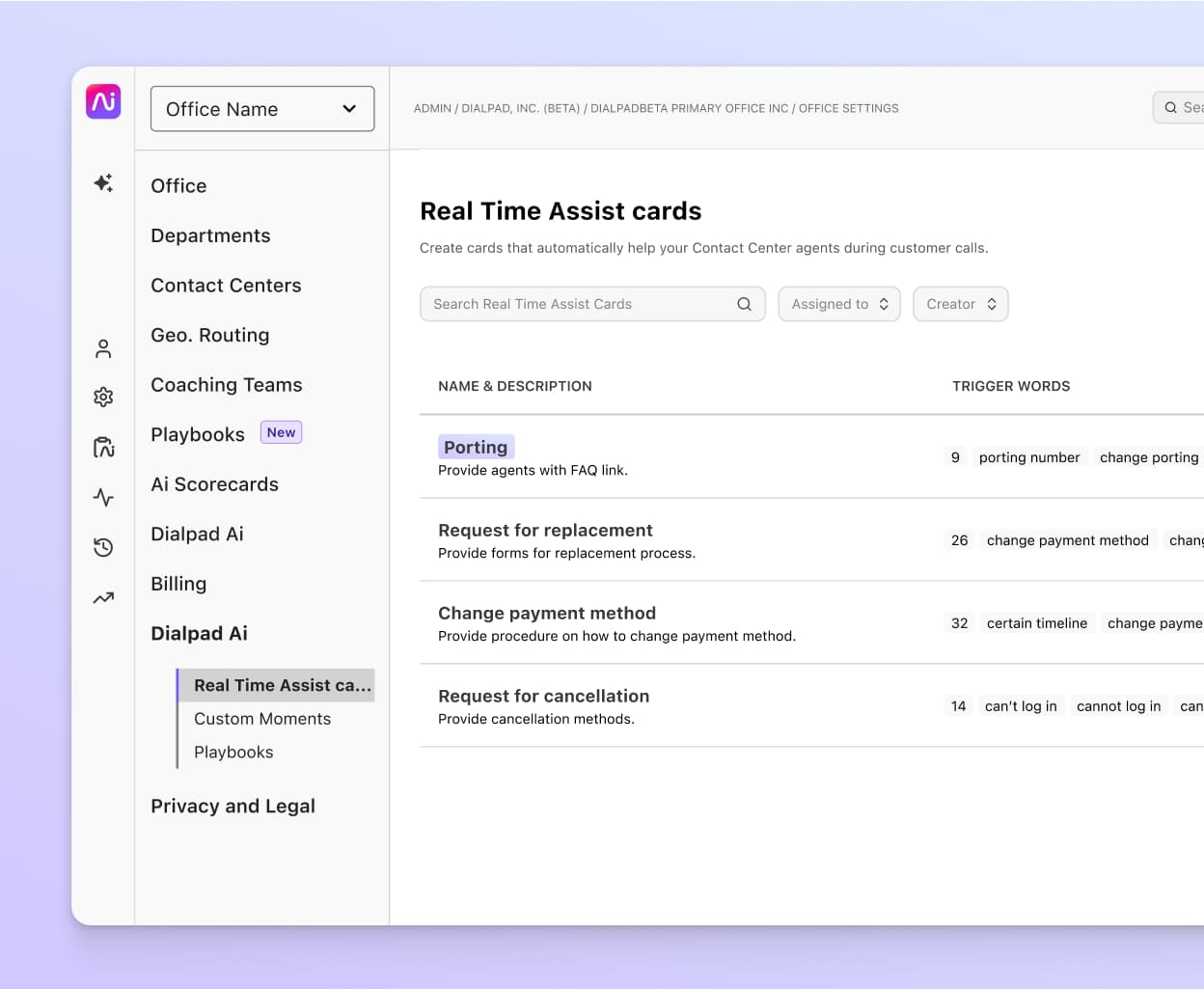
Responding to positive reviews
Any response to a good review should at the very least show gratitude. Make it personal. Address your happy customer by name and focus on the points they’ve made. Anything generic will be obvious and this is one place you don't want to just copy and paste from a template. (Thank you notes are so short anyway—you're not really saving that much time.)
Don’t use the opportunity to upsell new products at this stage. This will come across as a hard-sell and isn't a good look. Keep it simple, thank them for reviewing your product, and resist the urge to flog something new. Building a few relationship blocks is all you need to focus on.
Keep in mind that other customers (and potential customers) will also be reading your reply.
Finally, choose the reviews that you respond to wisely. If you work at a huge company and get thousands of reviews every day, it's probably not possible to respond to every single one. Look for reviews which potentially offer value for both parties, as well as other readers.
Short, one-line reviews (“Nice earbuds.”) may not be worth your time and effort. But a keenly-written essay that discusses your product in detail (“I couldn't hear my neighbor's baby crying when I had these earbuds in…”) could be the start of a beautiful friendship.
Responding to negative reviews
As with positive reviews, it may not be necessary to respond to every negative comment. Some negative reviews (“Two star rating—slow loading speeds”) may be perfectly contrasted by positive reviews that say the opposite. In such cases, you can leave other customers to make up their own minds.
But if someone raises a specific problem or says something that's just inaccurate, then you should respond quickly and clearly.
Be humble and apologise (you'd be surprised at many companies don't actually apologise when something goes wrong) and make sure your response shows the customer—and all other readers of the review—what steps you're taking to fix the problem.
Most online websites (Google, Amazon, you name it) allow customers to update their original reviews to show that their problem has been resolved, so a bad initial review isn't the end of the road:

Ready to get more customer reviews for your business?
No matter how amazing your marketing team is, it can always use the added firepower that great customer reviews can give you.
If your business needs some more social proof about how awesome your product or customer experience is, give these methods a try!
Want to provide a better customer experience—and get more glowing reviews?
Book a demo of Dialpad Ai Contact Centre to see how it can help you be more responsive to customers, or take a self-guided interactive tour of the app on your own first!








